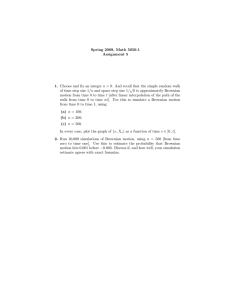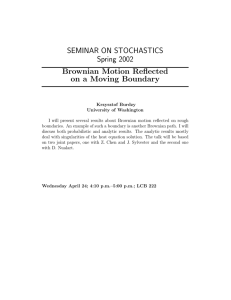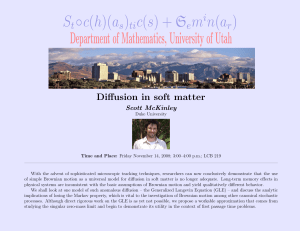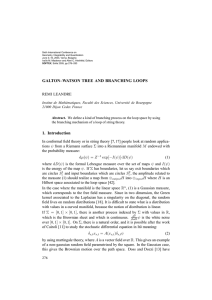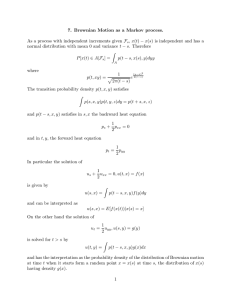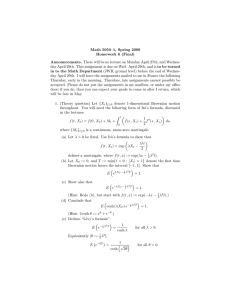August 23, 2004 17:7 WSPC/102-IDAQPRT 00171
advertisement
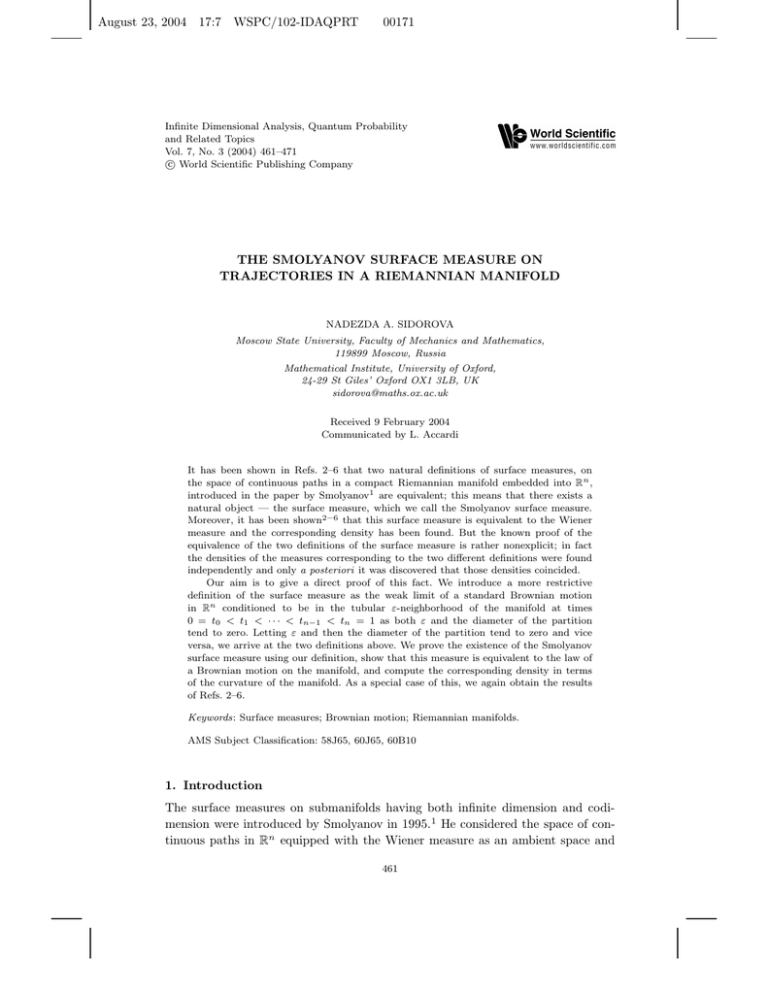
August 23, 2004 17:7 WSPC/102-IDAQPRT
00171
Infinite Dimensional Analysis, Quantum Probability
and Related Topics
Vol. 7, No. 3 (2004) 461–471
c World Scientific Publishing Company
THE SMOLYANOV SURFACE MEASURE ON
TRAJECTORIES IN A RIEMANNIAN MANIFOLD
NADEZDA A. SIDOROVA
Moscow State University, Faculty of Mechanics and Mathematics,
119899 Moscow, Russia
Mathematical Institute, University of Oxford,
24-29 St Giles’ Oxford OX1 3LB, UK
sidorova@maths.ox.ac.uk
Received 9 February 2004
Communicated by L. Accardi
It has been shown in Refs. 2–6 that two natural definitions of surface measures, on
the space of continuous paths in a compact Riemannian manifold embedded into R n ,
introduced in the paper by Smolyanov1 are equivalent; this means that there exists a
natural object — the surface measure, which we call the Smolyanov surface measure.
Moreover, it has been shown2 – 6 that this surface measure is equivalent to the Wiener
measure and the corresponding density has been found. But the known proof of the
equivalence of the two definitions of the surface measure is rather nonexplicit; in fact
the densities of the measures corresponding to the two different definitions were found
independently and only a posteriori it was discovered that those densities coincided.
Our aim is to give a direct proof of this fact. We introduce a more restrictive
definition of the surface measure as the weak limit of a standard Brownian motion
in Rn conditioned to be in the tubular ε-neighborhood of the manifold at times
0 = t0 < t1 < · · · < tn−1 < tn = 1 as both ε and the diameter of the partition
tend to zero. Letting ε and then the diameter of the partition tend to zero and vice
versa, we arrive at the two definitions above. We prove the existence of the Smolyanov
surface measure using our definition, show that this measure is equivalent to the law of
a Brownian motion on the manifold, and compute the corresponding density in terms
of the curvature of the manifold. As a special case of this, we again obtain the results
of Refs. 2–6.
Keywords: Surface measures; Brownian motion; Riemannian manifolds.
AMS Subject Classification: 58J65, 60J65, 60B10
1. Introduction
The surface measures on submanifolds having both infinite dimension and codimension were introduced by Smolyanov in 1995.1 He considered the space of continuous paths in Rn equipped with the Wiener measure as an ambient space and
461
August 23, 2004 17:7 WSPC/102-IDAQPRT
462
00171
N. A. Sidorova
the subspace of continuous paths in a compact Lie grop G ⊂ Rn as a submanifold.a
In fact, that paper introduced the two different definitions of the surface measure
mentioned above and it was noted that (in this case), both measures coincide with
the Wiener measures on trajectories in the Lie group G. Both definitions can also be
applied to the case when the Lie group is replaced with any Riemannian manifold.
For that more general case the surface measures were investigated in Refs. 2–6.
Let M be a compact Riemannian manifold and a0 ∈ M . Denote by
Ca0 ([0, 1], Rn ) the space of continuous real-valued functions on [0, 1] taking value
a0 at zero, and by Ca0 ([0, 1], M ) its subset consisting of M -valued functions.
One of the natural ways1 to define a surface measure on Ca0 ([0, 1], M ) corresponding to the Wiener measure W on the ambient space is to force the Brownian
particle to be in the manifold at times 0 = t0 < t1 < · · · < tn−1 < tn = 1 and to
let the mesh of the partition P go to zero. More precisely, the surface measure is
defined as the weak limit
S1 = lim W(·|ωti ∈ M for all ti ∈ P ) .
|P |→0
(1.1)
With the help of explicit estimates for the short time asymptotics of the conditional
integral operator and using the semigroup theory it has been proved2,3,5 that S1
exists, is equivalent to the Wiener measure WM on Ca0 ([0, 1], M ), and the density
has been computed explicitly in terms of the mean and scalar curvature of the
manifold.
The second way1 to define a surface measure on Ca0 ([0, 1], M ) corresponding to
the standard Brownian motion on Rn is to condition on the event that the Brownian
particle does not leave the tubular ε-neighborhood Mε of M for the whole time,
and then let ε go to zero, i.e.
S2 = lim W(·|ωt ∈ Mε for all t ∈ [0, 1]) .
ε→0
(1.2)
It has been proved4,6 using mainly SDE techniques that S2 also exists, is equivalent
to WM and the density appears to be the same as of S1 (although there was no
direct proof that S1 = S2 ).
In the present paper we introduce a more restrictive definition of the surface
measure. Namely, let
WP,ε = W(·|ωti ∈ Mε for all ti ∈ P )
(1.3)
S = lim WP,ε .
(1.4)
and
|P |→0
ε→0
a For
submanifolds of infinite-dimensional spaces, having finite codimension, the definitions and
properties of surface measures can be (relatively) easily obtained in the frame of the theory
of differentiable measures initiated by Fomin (see Ref. 12) (where in particular the notion of
logarithmic derivative of a measure has been introduced). In this framework the theory of surface
measures on submanifolds of finite codimension has been developed by Uglanov 16 (see also Refs. 13
and 15).
August 23, 2004 17:7 WSPC/102-IDAQPRT
00171
The Smolyanov Surface Measure on Trajectories
463
It is easy to see that
S1 = lim lim WP,ε
|P |→0 ε→0
and S2 = lim lim WP,ε .
ε→0 |P |→0
(1.5)
We prove the existence of S (which implies the existence of S1 and S2 ) and compute
its density with respect to WM (which must certainly be the same as of S1 and S2 )
in an easier way.
Let us also notice that in Refs. 9, 10, it is shown that the definition of S1 is well
adapted to obtaining the Feynman–Kac type formulas for Schrödinger equations
on manifolds and the definition of S2 is adapted to develop some change of variable formulas for Wiener measures and Feynman pseudomeasures on trajectories
in manifolds. In particular the same density appears in the context of the study
of the holonomic constraints in quantum mechanics.8 – 10,14 Hence the geometric
potential in the density can be interpreted as an additional effective potential in
the Schrödinger equation on the manifold.8 – 11
We use the following notation. We assume that ε0 is small enough and the
orthogonal projection π : Mε0 → M is well defined (and we consider ε < ε0 ).
We denote by Ta M the tangent space of M at a ∈ M and by Na M the normal
space of M at π(a), for a ∈ Mε0 . In the sequel, we identify these spaces with
the corresponding subspaces in Rn . Further, for each x ∈ M , let Px denote the
orthogonal projection of Rn onto Tx M and Qx = I − Px denote the orthogonal
projection of Rn onto Nx M . For x ∈ M and w ∈ Tx M , we define
Γx (w) = dQx (w)Px + dPx (w)Qx ∈ gl(n) .
(1.6)
We denote by pr1 : Rn → Rm (respectively, pr2 : Rn → Rk ) the linear operator that
maps u ∈ Rn to its first m (respectively, to its last k) coordinates and by pr−1
1 :
k
n
Rm → Rn (respectively, pr−1
:
R
→
R
)
the
right
inverse
to
pr
(respectively,
1
2
−1
to pr2 ) such that pr−1
1 pr1 = Pa0 (respectively, pr2 pr2 = Qa0 ). Besides, we fix an
orthonormal basis (ei ) in Rn (such that its first m vectors generate Ta0 M ) and
identify all linear operators on Rn with their matrices with respect to (ei ). We also
use the Einstein summation convention: an index occurring twice in a product is
to be summed from one up to the space dimension.
Furthermore, we use the notion of the Fermi decomposition of a continuous
Mε0 -valued semimartingale.6 First, for every such semimartingale (ξt ) we define
xt = π(ξt ). Secondly, we denote by (ut ) the matrix-valued process that performs
stochastic parallel translation along (xt ), i.e. (ut ) is a solution of
δut + Γxt (δxt )ut = 0 with u0 = I .
(1.7)
Finally, we define zt = pr2 uTt (ξt − xt ). The triple (xt , ut , zt ) is called the Fermi
decomposition of (ξt ). It is easy to see that (ξt ) can be reconstructed from its Fermi
decomposition by the formula
ξt = xt + ut pr−1
2 zt .
(1.8)
August 23, 2004 17:7 WSPC/102-IDAQPRT
464
00171
N. A. Sidorova
The structure of the proof of our main result is similar to the proof about S2
although each step has undergone a significant change. In Sec. 2 we define the
optimal vector field v on Rn (which is in contrast to the shifting vector field6 no
longer orthogonal to the manifold) and compute its norm and divergence at points
on M in terms of the mean and the scalar curvature of M . In Sec. 3 we define a
new process (yt ) by
dyt = dbt − 1 v(yt )dt ,
2
(1.9)
y0 = a 0 ,
which we call a Brownian motion with the optimal drift. Further, writing down the
Fermi decomposition (xt , ut , zt ) of (yt ), using the fact that (zt ) turns out to be a
k-dimensional Brownian motion independent of the Brownian motion driving the
SDE for (xt ), and taking into account the continuity of the paths of (yt ), we show
that the generalized surface measure corresponding to (yt ) exists and coincides with
WM . Finally, in Sec. 4 we prove our main result using the equivalence of the laws
of (yt ) and a standard Brownian motion and the continuity of the corresponding
density, which is provided by the fact that v is of the gradient type.
2. Logarithmic Density ϕ and Optimal Vector Field v
In order to define the optimal vector field v mentioned in the Introduction, notice
that there are two natural measures λn and λ⊕ on Mε0 . The first one is just the
Lebesgue measure on Rn restricted to Mε0 ⊂ Rn . The second one is defined by
Z
λ⊕ (A) =
λk (Ax )dλM (x) , A ⊂ Mε0 Borel ,
(2.1)
π(A)
where Ax = π −1 (x) and λk and λM are the Lebesgue measures on Rk and M ,
respectively. We have used here the fact that Ax ⊂ Nx M and that there is a linear
isometry between Nx M and Rk . Moreover, the Lebesgue measure λk is independent
of the choice of such an isometry and hence λ⊕ is well-defined.
It has been proved6 that λ⊕ is equivalent to λn . Denote
ϕ = log
dλn
dλ⊕
(2.2)
and define
v = ∇ϕ .
(2.3)
Furthermore, denote by the same symbol a smooth extension of v to Rn that is
equal to zero outside a neighborhood of M (the choice of such an extension is not
essential).
Definition 2.1. The vector field v is called the optimal vector field.
August 23, 2004 17:7 WSPC/102-IDAQPRT
00171
The Smolyanov Surface Measure on Trajectories
465
Lemma 2.1. For any a ∈ M we have
kv(a)k2 = k∇ϕ(a)k2 = m2 kκk2 (a) ,
(2.4)
div v(a) = ∆ϕ(a) = R(a) ,
(2.5)
where κ is the mean curvature vector and R the scalar curvature of M .
Proof. Consider an orthogonal coordinate system (x1 , . . . , xm , z 1 , . . . , z k ) centered
at a such that its first m basis vectors form an orthogonal basis of the tangent
space Ta M . Let us compute ∇ϕ(a) and ∆ϕ(a) with respect to this system. By
the implicit function theorem, in this coordinate system the manifold M can be
represented locally in a neighborhood of the point a by a system of equations
z s = fs (x1 , . . . , xm ). Notice that ∂i fs (0) = 0, for all i, s. Further, denote by Fs =
Hessfs (0).
It follows from Lemma 9 in Ref. 6 that ϕ|M = 0 and so ϕ(x, f (x)) = 0. Differentiating it with respect to xi and taking into account the equalities ∂xi fs (0) = 0
we obtain for every 1 ≤ i ≤ m
∂xi ϕ(0, 0) = 0 .
(2.6)
Again by Lemma 9 in Ref. 6 we obtain for every 1 ≤ p ≤ k
∂zp ϕ(0, z) = −∂zp log det[I − z s Fs ]−1
= tr ∂zp log[I − z s Fs ] = −tr([I − z s Fs ]−1 Fp ) .
(2.7)
It follows now from Lemma 5 in Ref. 6 that
m
k
X
X
kv(a)k2 = k∇ϕ(a)k2 =
[∂xi φ(0, 0)]2 +
[∂zp φ(0, 0)]2
p=1
i=1
=
k
X
(tr Fp )2 = m2 kκk2 (a) .
(2.8)
p=1
Further, differentiating ϕ(x, f (x)) = 0 twice with respect to xi and taking into
account ∂xi fs (0, 0) = 0 and (2.7) we obtain
m
X
∂xi xi φ(0, 0) = −
k
X
∂zp φ(0, 0)
p=1
i=1
p=1
(tr Fp )2 .
(2.9)
p=1
(2.10)
[(tr Fp )2 − tr(Fp )2 ] = R(a) ,
(2.11)
p=1
and Lemma 4 in Ref. 6 implies
k
X
p=1
which completes the proof.
k
X
k
X
tr(Fp )2
∂zp zp ϕ(0, 0) = −
div v(a) = ∆ϕ(a) =
∂xi xi fp (0) =
i=1
Finally, it follows from (2.7) that
k
X
m
X
August 23, 2004 17:7 WSPC/102-IDAQPRT
466
00171
N. A. Sidorova
3. Brownian Motion with the Optimal Drift and its Surface
Measure
Since the optimal vector field v is compactly supported, there is a unique solution
(yt ) of the stochastic differential equation
dyt = dbt − 1 v(yt )dt ,
2
(3.1)
y0 = a 0 .
Definition 3.1. The process (yt ) is called a Brownian motion with the optimal
drift.
Let τ be the exit time of (yt ) from Mε0 . Consider the stopped process (yt∧τ )
and denote by (xt , ut , zt ) its Fermi decomposition. Further, consider the process
Z t
b̃t =
uT
(3.2)
s dbs .
0
It is also an n-dimensional Brownian motion by the Lévy’s characterization theorem
since it is a continuous local martingale with db̃it db̃jt = δij dt by the orthogonality of
us for all s. Denote by b̃0t (respectively, by b̃00t ) the first m (respectively, the last k)
components of b̃t .
The following two lemmas are very similar to Lemmas 12, 13 in Ref. 6 and we
skip all the computations which can be taken from their proofs.
Lemma 3.1. The Itô differential of the process (xt ) up to time τ is given by
1
0
dxt = Dπ(yt )ut pr−1
1 db̃t + (−Dπ(yt )v(yt ) + ∆π(yt ))dt .
2
(3.3)
Proof. It follows from (3.2) that
db̃0t = pr1 uT
t dbt .
(3.4)
Further, since6 Im[Dπ(y)] = Tπ(y) M we have
T
Dπ(yt )ut pr−1
1 pr1 ut = Dπ(yt )
(3.5)
although pr−1
1 pr1 6= I. Now by Itô’s formula and using (3.1) we get up to time τ
1
dxt = dπ(yt ) = Dπ(yt )dyt + DDπ(yt )dyt dyt
2
1
1
T
v(y
)dt
+ ∆π(yt )dt
= Dπ(yt )ut pr−1
pr
u
db
−
t
t
1 t
1
2
2
1
0
= π(yt )ut pr−1
1 db̃t + (−Dπ(yt )v(yt ) + ∆π(yt ))dt ,
2
which completes the proof.
Lemma 3.2. zt = b̃00t up to time τ .
(3.6)
August 23, 2004 17:7 WSPC/102-IDAQPRT
00171
The Smolyanov Surface Measure on Trajectories
467
Proof. Let us show that the Stratonovich differentials of the processes (zt ) and
(b̃00t ) coincide. Denote Jt = pr2 uT
t . It follows from Lemma 13 in Ref. 6 that
1
δ b̃00t = Jt δbt + Jt dPxt (δxt )δbt .
2
(3.7)
1
dzt = Jt δyt = Jt δbt − Jt v(yt )dt .
2
(3.8)
Furthermore, we have
It remains to show that Jt dPxt (δxt )δbt = −Jt v(yt )dt. But this is true since for
each a ∈ Mε0 the projection of v(a) onto the normal space Na M differs from the
projection of the shifting vector field6 only by the minus sign and therefore we can
use the last equality from the proof of Lemma 13.6 This implies δzt = δ b̃00t and
zt = b̃00t since this stochastic differential equation is exact.
Denote by Ly the measure on Ca0 ([0, 1], Rn ) which is the law of the process (yt )
and define the generalized surface measure Sy corresponding to (yt ) analogously
to the definition of the generalized surface measure corresponding to a Brownian
motion. Namely, we define
WyP,ε = Ly (·|ωti ∈ Mε for all ti ∈ P ) ,
(3.9)
Sy = lim WyP,ε ,
(3.10)
and
|P |→0
ε→0
where P : 0 = t0 < t1 < · · · < tn−1 < tn = 1 and the limit is to be understood in
the weak sense.
Proposition 3.1. Sy = WM .
Proof. It follows from Lemmas 3.1, 3.2 and (1.8) that the processes (xt , ut , zt )
from the Fermi decomposition of (yt ) satisfy (up to the exit time τ ) the following
system of stochastic differential equations:
0
dxt = σ(xt , ut , zt )dbt + c(xt , ut , zt )dt ,
dzt = db00t ,
(3.11)
dut = Γxt (δxt ) ,
where (b0t ) and (b00t ) are two independent Brownian motions, the coefficients σ and
c are given by
−1
σ(x, u, z) = Dπ(x + u pr−1
2 z)u pr1 ,
(3.12)
1
1
−1
−1
c(x, u, z) = − Dπ(x + u pr−1
2 z)v(x + u pr2 z) + ∆π(x + u pr2 z) ,
2
2
(3.13)
and the last equation in (3.11) is just the equation of the parallel translation.
August 23, 2004 17:7 WSPC/102-IDAQPRT
468
00171
N. A. Sidorova
Consider any probability space on which there is an n-dimensional Brownian
motion (b∗t ) and a family (ztP,ε ) of processes such that each (ztP,ε ) has the same
law as a k-dimensional Brownian motion conditioned to be in the ε-ball at times
ti ∈ P , and the whole family {(ztP,ε )} is independent of (b∗t ). On this probability
space we consider the filtration (Ft ) generated by {b∗s , s ≤ t} and all the processes
(ztP,ε ), 0 ≤ t ≤ 1. Then (pr1 b∗t ) is an m-dimensional (Ft )-Brownian motion.
P,ε
Let us show that the solution (xP,ε
t , ut ) of the system
P,ε P,ε
P,ε
P,ε P,ε
∗
dxP,ε
= σ(xP,ε
t
t , ut , zt )pr1 dbt + c(xt , ut , zt )dt ,
(3.14)
duP,ε
= ΓxP,ε (δxP,ε
t
t )
t
converges locally uniformly in probability to the solution (x̄t , ūt ) of the system
(
dx̄t = σ(x̄t , ūt , 0)pr1 db∗t + c(x̄t , ūt , 0)dt ,
(3.15)
dūt = Γx̄t (δx̄t ) .
P,ε
P,ε
To do this, denote the processes (xP,ε
t , ut ) and (x̄t , ūt ) by (at ) and (āt ),
respectively, and rewrite the systems (3.14) and (3.15) in the form
P,ε
P,ε P,ε
∗
daP,ε
= f1 (aP,ε
t
t , zt )dbt + f2 (at , zt )dt
(3.16)
dāt = f1 (āt , 0)db∗t + f2 (āt , 0)dt ,
(3.17)
and
respectively, with the same initial conditions, where fi are the abbreviations for the
coefficients in (3.14) and (3.15) and notice that
fi (a, z) → fi (a, 0) as z → 0 ,
i = 1, 2 ,
(3.18)
uniformly in a and the functions fi (x, 0) are Lipschitz.
Now, denote
2
ϕP,ε (t) = E sup kaP,ε
s − ās k .
(3.19)
s≤t
It suffices to show that ϕP,ε (1) → 0 as ε → 0, |P | → 0.
Let δ > 0. According to the uniform convergence of fi , choose ε0 such that for
all a and for all z with kzk ≤ ε0 holds
kfi (a, z) − fi (a, 0)k < δ ,
i = 1, 2 .
Further, notice that
P sup kzsP,ε k > ε0 → 0 as ε → 0 and |P | → 0
(3.20)
(3.21)
0≤s≤1
since (ztP,ε ) is a conditioned Brownian motion. So there exist ε̄ > 0 and θ > 0 such
that for all ε < ε̄ and all P with |P | < θ holds
P sup kzsP,ε k > ε0 < δ 2 .
(3.22)
0≤s≤1
August 23, 2004 17:7 WSPC/102-IDAQPRT
00171
469
The Smolyanov Surface Measure on Trajectories
Using the moment estimates analogously to Lemma 16 of Ref. 6 and using
additionally (3.22), the boundedness of f1 , f2 , and the choice of ε0 , ε̄ and θ we get
for all ε < ε̄ and all P such that |P | < θ
X Z t
2
P,ε
E
kfi (aP,ε
ϕP,ε (t) ≤ c1
s , zs ) − fi (ās , 0)k ds
0
i=1,2
≤ c2
X
E
i=1,2
≤ c2
X
i=1,2
+ c2
Z
t
0
E 1(
X
Z
2
sup
kzsP,ε k>ε0
0≤s≤1
)
Z
t
0
P,ε
P,ε
2
kfi (aP,ε
s , zs ) − fi (as , 0)k ds
P,ε
E 1{sup
k≤ε0 }
0≤s≤1 kzs
i=1,2
+ c3 E
P,ε
P,ε
2
P,ε
2
{kfi (aP,ε
s , zs ) − fi (as , 0)k + kfi (as , 0) − fi (ās , 0)k }ds
Z
t
0
P,ε
kfi (aP,ε
s , zs )
−
2
fi (aP,ε
s , 0)k ds
t
0
≤ c4 δ + c3
2
kaP,ε
u − āu k du
Z
t
ϕP,ε (u)du, for all t ,
(3.23)
0
where c1 , c2 , c3 and c4 are positive constants independent of δ. Now by Gronwall’s
lemma
ϕP,ε (t) ≤ c4 δ 2 ec3 t
(3.24)
ϕP,ε (1) ≤ c2 δ 2 ec3
(3.25)
and in particular
for all ε < ε̄ and all P such that |P | < θ. Hence ϕP,ε (1) → 0 and the process (xP,ε
t )
converge to (x̄t ) locally uniformly in probability.
Now it remains to show that (x̄t ) is a Brownian motion on M . Analogously to
the proof of Proposition 15 in Ref. 6 we have
∗
∗∗
∗∗
∗
∗
2
Dπ(x̄t )ūt pr−1
1 pr1 dbt = Px̄t ūt Pa0 dbt = Px̄t ūt dbt = Px̄t dbt = Dπ(x̄t )dbt , (3.26)
where (b∗∗
t ) is another n-dimensional Brownian motion. Further, it follows from the
proof of Lemma 2.1 that v(x) ∈ Nx M for x ∈ M . This together with (3.12) and
(3.13) implies
dx̄t = σ(x̄t , ūt , 0)pr1 db∗t + c(x̄t , ūt , 0)dt
1
1
∗
= Dπ(x̄t )ūt pr−1
1 pr1 dbt − Px̄t v(x̄t )dt + ∆π(x̄t )dt
2
2
1
= Dπ(x̄t )db∗∗
t + ∆π(x̄t )dt ,
2
(3.27)
August 23, 2004 17:7 WSPC/102-IDAQPRT
470
00171
N. A. Sidorova
which is equivalent to δx̄t = Px̄t δb∗∗
t and therefore means that (x̄t ) is a Brownian
motion on M .
4. Surface Measure of a Standard Brownian Motion
We are going to prove the existence of S and to compute its density with respect
to the Wiener measure WM using our knowledge of the measure Sy . It follows
from the Girsanov Theorem that the laws of (bt ) and (yt ) are equivalent, and the
corresponding density is given by
Z 1
Z
1 1
dW
1
2
hv(bt ), dbt i +
kv(bt )k dt .
(4.1)
= exp
ρ=
dLy
2 0
8 0
Moreover, using Itô’s formula and the fact that v is of the gradient type, we obtain
Z 1
Z
1 1
1
h∇φ(ωt ), dωt i +
k∇φ(ωt )k2 dt
ρ(ω) = exp
2 0
8 0
Z 1
∆φ(ωt ) k∇φ(ωt )k2
φ(ω1 ) − φ(ω0 )
+
−
+
dt , (4.2)
= exp
2
4
8
0
which means that ρ is continuous and bounded.
Theorem 4.1. The generalized surface measure S exists and is equivalent to the
Wiener measure WM . The corresponding density is given by
Z 1
R m2 kκk2
dS
(ω) = C exp
− +
(ωt )dt ,
(4.3)
dWM
4
8
0
where R is the scalar curvature, κ is the mean curvature vector of M, and C is the
normalizing constant.
Proof. Let h : Ca0 ([0, 1], Rn ) → R be continuous and bounded. Denote by E, Ey ,
EP,ε , EyP,ε , and EM the expectations with respect to the measures W, Ly , WP,ε ,
WyP,ε , and WM , respectively. Further, denote 1P,ε = 1XP,ε , where
XP,ε = {ω ∈ Ca0 ([0, 1], Rn ) : ωti ∈ Mε for all ti ∈ P } .
(4.4)
By Proposition 3.1 and using the continuity and boundedness of ρ we obtain
Ey 1P,ε ρh
Ey 1P,ε ρh Ey 1P,ε
E1P,ε h
= lim
= lim
· y
y
|P |→0 E 1P,ε ρ
|P |→0
|P |→0 E1P,ε
Ey 1P,ε
E 1P,ε ρ
lim EP,ε h = lim
|P |→0
ε→0
ε→0
ε→0
EyP,ε ρh
ε→0
EM ρh
ρ
=
= EM h
= lim
.
y
|P |→0 E
EM ρ
EM ρ
P,ε ρ
ε→0
(4.5)
Denote C = [EM ρ]−1 .
It remains to compute the restriction of ρ to M . By Lemma 9 of Ref. 6 we have
φ(a) = 0 for all a ∈ M and using Lemma 2.1 we obtain
August 23, 2004 17:7 WSPC/102-IDAQPRT
00171
The Smolyanov Surface Measure on Trajectories
ρ
EM ρ
(ω) = C exp
Z
1
0
R m2 kκk2
− +
4
8
(ωt )dt ,
471
(4.6)
for every ω ∈ Ca0 ([0, 1], M ), and the theorem is proved.
References
1. O. G. Smolyanov, Smooth measures on loop groups, Dokl. Math. 52 (1995) 408–411.
2. O. G. Smolyanov, H. V. Weizsäcker and O. Wittich, Brownian motion on a manifold
as limit of stepwise conditioned standard Brownian motions, Can. Math. Soc. Conf.
Proc. 29 (2000) 589–602.
3. O. G. Smolyanov, H. V. Weizsäcker and O. Wittich, Diffusion on a compact Riemannian manifold and surface measures, Dokl. Math. 371 (2000) 442–447 (Russian
edition).
4. N. A. Sidorova, O. G. Smolyanov, H. V. Weizsaecker and O. Wittich, Wiener surface
measures on trajectories in Riemannian manifolds, Dokl. Math. 65 (2002) 234–244.
5. O. G. Smolyanov, H. V. Weizsäcker and O. Wittich, Chernoff’s theorem and the
construction of semigroups, Prog. Nonlinear Differential Eqs. Their Appl. 55 (2003)
349–358.
6. N. A. Sidorova, O. G. Smolyanov, H. V. Weizsaecker and O. Wittich, The surface
limit of Brownian motion in tubular neighbourhoods of an embedded Riemannian
manifold, J. Funct. Anal. 206 (2004) 391–413.
7. N. A. Sidorova, Brownian motion on an embedded manifold as the limit of Brownian
motions with reflection in its tubular neighborhoods, Math. Notes 73 (2003) 895–899.
8. I. Davies, O. G. Smolyanov and A. Truman, Functional integral representations of
solutions for stochastic Schrödinger equations on compact Riemannian manifolds,
Dokl. Math. 373 (2000) 10–14 (Russian edition).
9. O. G. Smolyanov and A. Truman, Feynman–Kac formulas for solutions for Scrödinger
equations on compact Riemannian manifolds, Math. Notes 68 (2000) 789–793.
10. O. G. Smolyanov and A. Truman, Feynman integrals over trajectories in Riemannian
manifolds, Dokl. Math. 68 (2003) 194–198.
11. C. DeWitt-Morette, K. D. Elworthy, B. L. Nelson and G. Sammelman, A stochastic scheme for constructing solutions of the Schrödinger equations, Ann. Inst. Henri
Poincaré 32 (1980) 327–341.
12. V. I. Averbukh, O. G. Smolyanov and S. V. Fomin, Generalized functions and differential equations in linear spaces I: Differentiale measures, Trans. Moscow Math. Soc.
24 (1971) 140–184.
13. H. Airault and P. Malliavin, Intégration géométrique sur l’espace de Wiener, Bull.
Sci. Math. 112 (1988) 3–52.
14. R. Froese and I. Herbst, Realizing holonomic constraints in classical and quantum
mechanics, Comm. Math. Phys. 220 (2001) 489–535.
15. A. V. Skorokhod, Integration in Hilbert Space (Springer, 1974).
16. A. V. Uglanov, Surface integrals in Banach spaces, Math. USSR Sbor. 38 (1981)
175–203.

